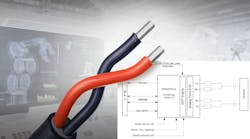Transceiver Exceeds IEEE Single-Pair Ethernet Standard with Extended Reach, Speed
We expect a lot from Ethernet these days: gigabit-per-second speeds (GbE), optical Ethernet, and using it as a power-delivery conduit via Power over Ethernet (PoE). Now, users—primarily those in the industrial arena—are asking for and getting Ethernet with fewer conductors, while accepting lower speeds.
Dubbed Single-Pair Ethernet (SPE), it’s defined by IEEE802.3cg and getting a lot of attention. While it may seem a step backward to have a lower maximum rate, it’s largely a matter of perspective. For the myriad sensors of the industrial Internet of Things (IIoT), the requisite data rates are far slower than those for “conventional” internet applications, while cost and bulk of wiring is a major consideration.
Of course, it’s one thing to define a standard, and another to make it happen. With single-pair Ethernet, it begins with the availability of physical-layer (PHY) transceivers that are designed for the challenging requirements of the SPE standard. The DP83TD510E SPE transceiver IC from Texas Instruments reaches up to 1700 meters, thereby exceeding the baseline requirements of the IEEE 802.3cg 10BASE-T1L sub-specification, which calls for 10 Mb/s and up to 1000 meters through a single pair of twisted wires (Fig. 1).
The DP83TD510E enables designers to implement a single communications network—from controller to edge node—that can transmit full-duplex data over a single pair of twisted wires from sensors located in HVAC valve and actuator controls, field transmitters, elevator main controls, and fire-alarm control panels, for example.
To realize this level of performance, the transceiver embeds many sophisticated techniques such as adaptive echo cancellation. As a viable PHY transceiver is more than raw performance specifications, especially in the industrial environment, the device is also focused on issues related to low power, safety and failure modes, EMI/RFI, diagnostics, and other challenges.
Power requirements are low at 45 mW for 1-V p-p mode and 99 mW for 2.4-V p-p mode. The transceiver is also compliant with IEC 61000-4-4, the International Electrotechnical Commission's immunity standard based on electrical fast transient (EFT)/burst transients and CISPR22 radiated emission class B mandates, offering ±6-kV HBM ESD protection on media-dependent-interface (MDI) pins.
Diagnostic tools include cable open/short-circuit detection; TDR (time domain reflectometry); ALCD (active link cable diagnostics); receiver SQI (signal quality indicator) to measure cable degradation; multiple loopbacks; and integrated PRBS packet generator to ease debugging during development and detecting faulty conditions in field.
Aligned with the needs of the industrial environment, the DP83TD510E is designed for use in intrinsically safe Ethernet advanced physical-layer (APL) systems. (Ethernet-APL, an Ethernet specification based on the IEEE 802.3.cg 10BASE-T1L standard, was developed to simplify implementation of Ethernet networking in process automation systems with intrinsic safety requirements.) This includes the ability to reduce Ethernet PHY power levels and temperature during system failure conditions. By supporting external termination resistors, the DP83TD510E can reduce inrush current and maintain lower operating temperatures when used in long-distance applications.
The DP83TD510E transceiver is documented by a comprehensive 73-page datasheet. It supports single-supply operation from 3.3 V, as well as dual-supply operation for lower power dissipation, with I/O voltages of 1.8, 2.5, or 3.3 V. The device comes in a 5- × 5-mm, 32-pin QFN package with 0.5-mm pitch. Operating temperature range is −40 to 105°C. Pricing begins at $3.20 in 1,000-unit quantities.
An evaluation module is more than a convenience—it’s almost a necessity when designing-in a device such as this PHY transceiver for Single-Pair Ethernet. The associated DP83TD510E-EVM evaluation module ($149) (Fig. 2) supports 10-Mb/s speed and is IEEE 802.3cg-compliant.The DP83822I media converter board is provided for 10BASE-TX Standard Ethernet support and enables bit-error-rate testing, interoperability testing, and compliance testing (Fig. 3). The EVM can be powered by a 5- to 36-V power supply or through a microUSB cable, and is supported by a 43-page User’s Guide.
SPE References
Electronic Design, “Leveraging Single-Pair Ethernet in Building Automation”
Machine Design, “Single Pair Ethernet Changes Scope of Next-Gen Cabling Systems”
Texas Instruments, “How 10BASE-T1L single-pair Ethernet brings the network edge closer with fewer cables”
Standards Informant, “IEEE Std 802.3cg-2019: 10 Mb/s Single-Pair Ethernet”



